俺们都知道,智能手机可以通过旋转手机来改变屏幕的显示方向,更多的时候,对于屏幕方向的改变,我们要做出相应的处理,例如,当手机屏幕方向从纵向变为横向时,可能要重新排列页面上的控件以适应显示区域的变化。
前面我们讨论过,Silverlight for Windows Phone的页面布局有三个常用的布局控件,那么,当屏幕方向改变后,我们所做的对布局的更改基础上是基于这几个容器进行的操作。
本文我将通过三个示例来分别说明。
开始之前,先说一下PhoneApplicationPage类的OrientationChanged事件,该事件就是当屏幕的方向改变之后发生,我们从事件参数OrientationChangedEventArgs类的实例的Orientation属性中获取当前屏幕的方向,即改变后的方向,比如,原来屏幕是纵向,现在我把手机屏幕改为横向,则Orientation属性获取到的方向就是横向的,呵呵,当然也包括从哪个方向旋转过来的,这里只是举例而已。
要使页面支持旋转,要把PhoneApplicationPage的SupportedOrientations属性改为PortraitOrLandscape,然后可以通过定义OrientationChanged事件来处理布局。形如:
- <phone:PhoneApplicationPage
-
- ..............
- SupportedOrientations="PortraitOrLandscape"
- Orientation="Portrait"
- OrientationChanged="PhoneApplicationPage_OrientationChanged">
一、Grid控件的处理。
- <phone:PhoneApplicationPage
- x:Class="Sample_PageDir.Page1"
- xmlns="http://schemas.microsoft.com/winfx/2006/xaml/presentation"
- xmlns:x="http://schemas.microsoft.com/winfx/2006/xaml"
- xmlns:phone="clr-namespace:Microsoft.Phone.Controls;assembly=Microsoft.Phone"
- xmlns:shell="clr-namespace:Microsoft.Phone.Shell;assembly=Microsoft.Phone"
- xmlns:d="http://schemas.microsoft.com/expression/blend/2008"
- xmlns:mc="http://schemas.openxmlformats.org/markup-compatibility/2006"
- FontFamily="{StaticResource PhoneFontFamilyNormal}"
- FontSize="{StaticResource PhoneFontSizeNormal}"
- Foreground="{StaticResource PhoneForegroundBrush}"
- mc:Ignorable="d" d:DesignHeight="768" d:DesignWidth="480"
- shell:SystemTray.IsVisible="True"
- SupportedOrientations="PortraitOrLandscape"
- Orientation="Portrait"
- OrientationChanged="PhoneApplicationPage_OrientationChanged">
-
- <Grid x:Name="layoutRoot">
- <Grid.RowDefinitions>
- <RowDefinition Height="Auto" />
- <RowDefinition Height="Auto" />
- </Grid.RowDefinitions>
- <Grid.ColumnDefinitions>
- <ColumnDefinition Width="Auto" />
- <ColumnDefinition Width="Auto" />
- </Grid.ColumnDefinitions>
- <Image x:Name="img" Source="http://gubapic.eastmoney.com/member/e68/e681999/e68199920091216131540.jpg" Stretch="UniformToFill" Width="270" Grid.Row="0" Grid.Column="0" />
- <TextBlock x:Name="txtBlock"
- Grid.Row="1"
- Grid.Column="0"
- FontSize="70"
- Margin="28">
- <Run Foreground="Coral">信春哥</Run>
- <LineBreak/>
- <Run Foreground="Yellow">唱情歌</Run>
- <LineBreak/>
- <Run Foreground="SkyBlue">不挂科</Run>
- </TextBlock>
- </Grid>
-
- </phone:PhoneApplicationPage>
页面主要有两个控件,一个用于显示图片,一个用于显示文本信息,通过事件处理代码来相应改变两个控件的布局。
- private void PhoneApplicationPage_OrientationChanged(object sender, OrientationChangedEventArgs e)
- {
- // 如果是横向的
- if (e.Orientation == PageOrientation.Landscape ||
- e.Orientation == PageOrientation.LandscapeLeft ||
- e.Orientation == PageOrientation.LandscapeRight)
- {
- Grid.SetColumn(this.img, 0);
- Grid.SetRow(this.img, 0);
- Grid.SetRow(this.txtBlock, 0);
- Grid.SetColumn(this.txtBlock, 1);
- }
- // 如果是纵向
- else if (e.Orientation == PageOrientation.Portrait ||
- e.Orientation == PageOrientation.PortraitDown ||
- e.Orientation == PageOrientation.PortraitUp)
- {
- Grid.SetColumn(this.img, 0);
- Grid.SetRow(this.img, 0);
- Grid.SetRow(this.txtBlock, 1);
- Grid.SetColumn(this.txtBlock, 0);
- }
- else
- {
- Grid.SetColumn(this.img, 0);
- Grid.SetRow(this.img, 0);
- Grid.SetRow(this.txtBlock, 1);
- Grid.SetColumn(this.txtBlock, 0);
- }
- }
按F5运行程序,默认的屏幕方向是纵向的,如下图所示:
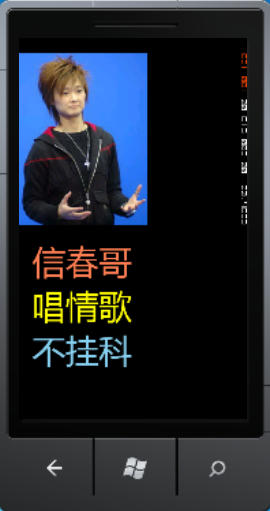
好,现在,我们把屏幕旋转一下,看看会怎么样。
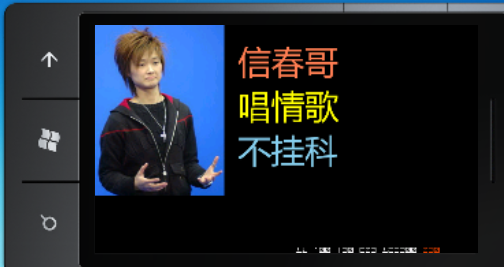
二、StackPanel控件的处理。
- <phone:PhoneApplicationPage
- x:Class="Sample_PageDir.Page2"
- xmlns="http://schemas.microsoft.com/winfx/2006/xaml/presentation"
- xmlns:x="http://schemas.microsoft.com/winfx/2006/xaml"
- xmlns:phone="clr-namespace:Microsoft.Phone.Controls;assembly=Microsoft.Phone"
- xmlns:shell="clr-namespace:Microsoft.Phone.Shell;assembly=Microsoft.Phone"
- xmlns:d="http://schemas.microsoft.com/expression/blend/2008"
- xmlns:mc="http://schemas.openxmlformats.org/markup-compatibility/2006"
- FontFamily="{StaticResource PhoneFontFamilyNormal}"
- FontSize="{StaticResource PhoneFontSizeNormal}"
- Foreground="{StaticResource PhoneForegroundBrush}"
- SupportedOrientations="PortraitOrLandscape"
- OrientationChanged="PhoneApplicationPage_OrientationChanged"
- Orientation="Portrait"
- mc:Ignorable="d" d:DesignHeight="768" d:DesignWidth="480"
- shell:SystemTray.IsVisible="True">
-
- <phone:PhoneApplicationPage.Resources>
- <Style TargetType="TextBlock">
- <Setter Property="FontSize" Value="46"/>
- </Style>
- </phone:PhoneApplicationPage.Resources>
-
- <StackPanel x:Name="pl">
- <TextBlock Text="文本一"/>
- <TextBlock Text="文本二"/>
- <TextBlock Text="文本三"/>
- </StackPanel>
- </phone:PhoneApplicationPage>
后台事件处理代码。
- private void PhoneApplicationPage_OrientationChanged(object sender, OrientationChangedEventArgs e)
- {
- if (e.Orientation == PageOrientation.Landscape ||
- e.Orientation == PageOrientation.LandscapeLeft ||
- e.Orientation == PageOrientation.LandscapeRight)
- {
- this.pl.Orientation = System.Windows.Controls.Orientation.Horizontal;
- }
- else
- {
- this.pl.Orientation = System.Windows.Controls.Orientation.Vertical;
- }
- }
运行,默认方向是纵向。
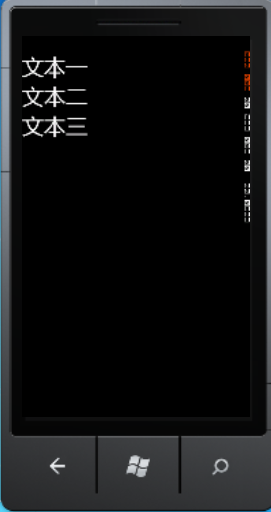
把屏幕旋转后。
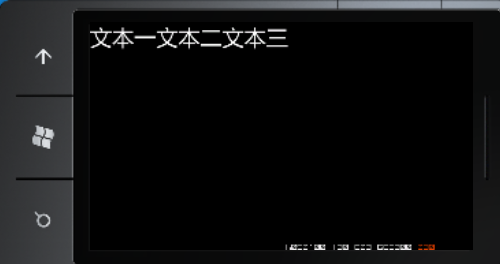
三、Canvas控件的处理。
- <phone:PhoneApplicationPage
- x:Class="Sample_PageDir.Page3"
- xmlns="http://schemas.microsoft.com/winfx/2006/xaml/presentation"
- xmlns:x="http://schemas.microsoft.com/winfx/2006/xaml"
- xmlns:phone="clr-namespace:Microsoft.Phone.Controls;assembly=Microsoft.Phone"
- xmlns:shell="clr-namespace:Microsoft.Phone.Shell;assembly=Microsoft.Phone"
- xmlns:d="http://schemas.microsoft.com/expression/blend/2008"
- xmlns:mc="http://schemas.openxmlformats.org/markup-compatibility/2006"
- FontFamily="{StaticResource PhoneFontFamilyNormal}"
- FontSize="{StaticResource PhoneFontSizeNormal}"
- Foreground="{StaticResource PhoneForegroundBrush}"
- SupportedOrientations="PortraitOrLandscape"
- Orientation="Portrait"
- OrientationChanged="PhoneApplicationPage_OrientationChanged"
- mc:Ignorable="d" d:DesignHeight="768" d:DesignWidth="480"
- shell:SystemTray.IsVisible="True">
-
- <Canvas x:Name="cv">
- <Rectangle x:Name="rect1"
- Width="232"
- Height="238"
- Fill="Red"
- Canvas.Left="88"
- Canvas.Top="88"/>
- <Rectangle x:Name="rect2"
- Height="192"
- Width="275"
- Fill="Yellow"
- Canvas.Top="268"
- Canvas.Left="155"/>
- </Canvas>
-
- </phone:PhoneApplicationPage>
后台代码。后台代码。
- private void PhoneApplicationPage_OrientationChanged(object sender, OrientationChangedEventArgs e)
- {
- if (e.Orientation== PageOrientation.Landscape||e.Orientation== PageOrientation.LandscapeLeft||e.Orientation== PageOrientation.LandscapeRight)
- {
- Canvas.SetTop(this.rect1, 37);
- Canvas.SetLeft(this.rect1, 46);
- Canvas.SetTop(this.rect2, 240);
- Canvas.SetLeft(this.rect2, 462);
- }
- else
- {
- Canvas.SetTop(this.rect1, 88);
- Canvas.SetLeft(this.rect1, 88);
- Canvas.SetTop(this.rect2, 268);
- Canvas.SetLeft(this.rect2, 155);
- }
- }
看看效果。看看效果。
纵向。

横向。
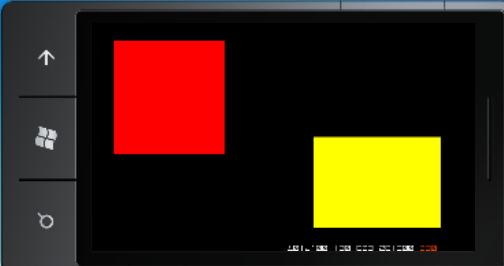
Windows Phone开发(6):处理屏幕方向的改变
原文:http://www.cnblogs.com/xieweikai/p/6833109.html





